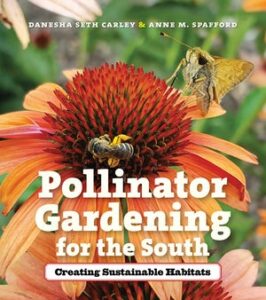My husband, Lloyd Brinson, was a science teacher for many years, and he’s also become a pretty accomplished gardener. He already knew a good bit about the importance of pollinators – he raises eyebrows in our neighborhood by carefully mowing around patches of blooming clover in our yard – but he still found much to interest him in this new book.
Reviewed by Lloyd Brinson
POLLINATOR GARDENING FOR THE SOUTH: Creating Sustainable Habitats. By Danesha Seth Carley and Anne M. Spafford. The University of North Carolina Press. 168 pages. Paperback, $24. Ebook, $18.99.
 By this time in the spring, you probably have already said some pretty unkind words (or worse!) about one insect or another. Before you find occasion to utter another expletive not deleted toward an unsuspecting flying critter, you might consider seeking a remedy for what could be a precursor to insectophobia.
By this time in the spring, you probably have already said some pretty unkind words (or worse!) about one insect or another. Before you find occasion to utter another expletive not deleted toward an unsuspecting flying critter, you might consider seeking a remedy for what could be a precursor to insectophobia.
You might consider reading Pollinator Gardening for the South, by Danesha Seth Carley and Anne M. Spafford, a delightful, easy to understand guidebook for keeping pollinating insects in their place – in flower and vegetable gardens that, while attractive, also serve to help shore up our fragile environment.
The authors, both associate professors of horticultural science at North Carolina State University, have combined solid science and delightful art and pictures to help anyone at any level of gardening to begin creating a pollinator-friendly garden of any size at any pace to suit any individual.
Not only is the science impeccable, this outdoor lover’s manual is full of wisdom, history and wonderful observations about nature, even human nature. While describing how some bees behave under differing circumstances in the chapter on “Butterflies, Bees and Beyond,” the authors remind us that:
“With bees, as with angry toddlers, swatting and yelling does not encourage them to settle down.”
As they describe the interweaving life and death struggles for survival of the insects and the plants, Spafford and Carley deliver insights into how dependent we are on the workings of the natural world. Notice I said how dependent we are. They quote biologist O. E. Wilson’s observation about ants:
“We need them to survive, but they don’t need us at all.”
Sometime while reading the first few chapters this book, my mind drifted back more than half a lifetime ago to the few years I spent in Polynesia and southeast Asia, where I regarded with wonder the myriad religious shrines, many surrounded with carefully attended plants of all types.
I believe I remembered those shrines because they were places of peace, reflection and a reminder of the good things in the world, the same feelings you can get while enjoying your pollinator garden.
There are also surprises in Pollinators, one of which puts me in a quandary. I’m a retired science teacher, and the neighborhood kids that come into our backyard to play basketball and frolic with our dog know that. We often discuss nature. They also love to sample the figs on the young trees at the corners of our patio/basketball court. So, as a dedicated, full disclosure scientist, am I obligated, after reading about fig wasps in Pollinators, to tell the whole story of how those tiny fig “flowers” get pollinated?
Probably not….